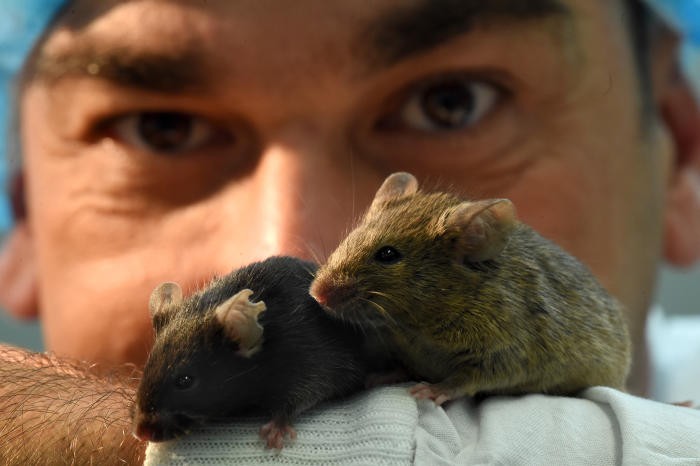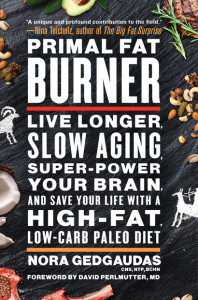Low Carb, Higher Fat Approach To Eating Bad For Mice, NOT Humans
By Nora Gedgaudas, CNS, NTP, BCHN
An article titled “Paleo diets = weight gain” released through the University of Melbourne has hit the mainstream press in no small way. In it, researchers are extolling the virtues of their new mouse study being used to decry low carbohydrate/high fat Paleo diets as “causing weight gain” and leading to other adverse metabolic changes leading to diabetes and other related symptoms.
In the ill-conceived but much ballyhooed study, two groups of overweight mice with pre-diabetes symptoms were split into separate groups. One group was placed on a low-carbohydrate (20%), high-fat (60%) diet (LCHF) supposedly “similar” to certain Paleo diets. The other group remained on their normal diet.
After eight weeks, the group on the LCHF diet gained more weight, their glucose intolerance worsened and their insulin levels rose. They gained 15 per cent of their body weight and their fat mass doubled from two per cent to almost four per cent.
Researchers pretended to be surprised that what they referred to as the “Paleo approach” didn’t help, and seemed to make the diabetic mice worse. This news made headlines everywhere in Australia where the Paleo diet has been gaining some real traction in recent years.
But is this study really an indictment of low carbohydrate, higher fat Paleo approaches to eating in humans… Or is it really just a carefully orchestrated attempt by certain vested interests to stop a growing trend toward improved health and away from corporate industrial profits?
There is so much wrong with this study it is hard to know where to start. If this wasn’t a blatant effort to intentionally smear the growing low-carb and Paleo movement, then at the very least someone who should have known better wasn’t thinking or paying attention.
For starters, the only way to fairly judge the effects of an ancestral diet on a mouse is to feed that mouse its own “ancestral diet”— not a human ancestral diet, which in truth bears no resemblance to the natural diet of a mouse.
But the real kicker here is the fact that the diet that the mice were eating doesn’t even come close to replicating– in any manner shape, or form–any existing manner of Paleo or ketogenic aproach to diet. In fact, I wouldn’t recommend this version of a supposed LCHF diet to my worst enemy. What did the mice’s supposed LCHF daily diet consist of?
- Cocoa butter (the mice’s primary source of fat. Really? As much as many Paleophiles love a bit of dark chocolate here and there, I have yet to meet one that uses cocoa butter as their primary fat source.)
- Canola oil (a GMO, highly processed, typically partially hydrogenated or interesterified industrial vegetable fat that depletes the body of vitamin E and has so many inherent problems associated with it–including the generation of heart lesions—it does not even deserve to be listed as any sort of “food”. Canola oil is ANYTHING but “Paleo”.)
- Casein (THE primary source of animal protein in this study—already known in numerous animal studies to have adverse effects—in fact casein was the animal protein conveniently used to disparage the health effects of animal protein in the massively flawed pro-vegetarian tome, ‘The China Study’ by T. Collin Campbell. Casein is a poorly digested and commonly antigenic protein found in cow’s milk—not anywhere on the LCHF Primal menu I promote in any way).
- Sucrose – Yes, you read right. Refined sugar was on the overweight, pre-diabetic mice’s supposedly “low carb” menu! The combination of sugar and fat is always very, very bad… Which is one reason why sugar is nearly always eliminated in LCHF diets. To paraphrase professor, researcher and biochemist, Dr. Richard Feinman, the deleterious effects of fat have always been measured in the presence of sugar/starch. Which is probably why they added it, frankly.
- Clarified butter fat (ghee). Again, we’re probably not talking about 100% grass-fed sources here. And ghee also contains other potentially antigenic trace dairy proteins, including casein.
- Cellulose (a.k.a., fiber. From where who knows. Could even be wood pulp or cardboard. They don’t specify. But I digress.)
- Calcium carbonate – literally the most worthless, least bioavailable form of calcium available. Known to be associated with arterial and coronary calcification in actual humans, btw.
- AIN93G vitamins (anyone’s guess as to what that specifically means, and from what sources. Given the menu so far I wouldn’t guess the sources are organic and non-synthetic)
- Potassium dihydrogen phosphate (inorganic and poorly bioavailable at best)
- DL-Methionine (What is it? “The starting materials for production of DL-methionine are acrolein (a 3-carbon aldehyde) derived from propylene (a petroleum derivative), methyl mercaptan derived from methanol and various sulfur sources and hydrocyanic acid (HCN). Acrolein and methyl mercaptan are reacted to form a relatively stable intermediate, 3-methylmercaptopropionaldehyde, known as MMP. The MMP is then reacted with HCN to form a rudimentary mix of DL-methionine and contaminants which is further refined through clean-up steps.”
- Sodium chloride (Pure sodium chloride was shown in one study to massively up-regulate IL-17 inflammatory pathways— an alarming recent finding. Nowhere in the diet I promote is refined salt on any “approved” list.
- Potassium citrate (ummm…ok)
- Choline chloride (a synthetic-source B-vitamin)
- Potassium sulfate (Inorganic and poorly bioavailable. And why are there three sources of potassium—with only one that isn’t 100% inorganic and poorly utilizable?)
- AIN93G trace minerals (again—what minerals…and from where? We are left to guess. I’m afraid to.)
THIS is the diet that supposedly proves a low carbohydrate/higher fat approach to eating is dangerous? They have got to be kidding. The fact that the [LCHF] mice actually improved in areas such as triglyceride levels and elevated HDL (not to mention even surviving the horrid processed nature of their supposedly “Paleo” diet) is a testament to what even a small lessening of the overall carbohydrate load can do.
There are ample HUMAN studies clearly extolling the considerable benefits of low carbohydrate, moderate protein and higher percentage fat “Paleo-oriented” diets in the existing literature. In fact, an article coming out of the UK in December featured a story about a nine year old Type 1 diabetic boy that came off of the need for insulin entirely following a fat-based, low-carb Paleo-oriented ketogenic diet. The article, based on a study published in the International Journal of Case Reports and Images stated: “After 19 months, the child is still on the Paleolithic ketogenic diet, and the researchers report it can ensure normoglycemia without the use of external insulin. No side effects or complications were observed, and the researchers stress the diet is sustainable in the long-term. They wrote: “We opine that the Paleolithic ketogenic diet ensures normal glucose levels and can be maintained on the long-term in those patients with newly diagnosed T1DM with residual insulin secretion.”
In the comment section of the article, a mother by the name of Beth McNally had the following to share, “Our 9 year old son was diagnosed in Canada in early Sept 2015. He was on the standard high carb diet and required insulin injections. In early November, 8 weeks after he was diagnosed we switched him to a Low Carb/High Fat diet, essentially a Keto/Paleo diet and he has been off insulin ever since. His blood sugars are stable even postprandial they rarely go above a 6.0 mmol/l. He has gained weight and grown in height since November. No hypo moments as he is not being administered any exogenous insulin. We hope to keep this going for as long as we can.”
Co-author of the research study, Csaba Tóth, MD had the following to add, “This is far beyond Honeymoon. Currently he is on the diet for 22 months. Almost 2 years. Actually “Honeyyears”. Note that the stimulated C peptid was in the normal range. In our previous case study C peptid increased within two months. This is the case in several our T1DM patients who are also on the diet but not yet published their case. Otherwise, on the standard diabetes diet, C peptid continue to decline after diagnosis. At two years the level of C peptide is typically about zero. Our data indicate halted autoimmune process.”
I, too have received countless emails and other reports from fans of my work over the years citing similar positive benefits as a result of adopting the fat-based ketogenic approach I promote in Primal Body, Primal Mind across a wide range of metabolic and other diseases. The list decidedly includes positive effects in those having type 1 & 2 diabetes, obesity, cardiovascular disease, autoimmunity, mood-related and/or cognitive/neurological issues and far more.
For that matter, anyone attending a Paleo event can tell you based on cursory observation that these are (at least on the surface of things) overall some of the healthiest looking people anyone would ever want to see— with the exception of those that are in the earlier stages of adopting this approach and still working toward reclaiming their health. Even the overweight people you run into at these events will typically tell you how much weight they have already lost, and how much better they feel and function following this dietary change.
The Paleo dietary approach has gained quite a bit of press in recent years and is unnerving the food industry, Big Agribusiness and other corporate interests that profit handsomely from a populace eating a carbohydrate-dominated diet. Low carb, fat-based versions of this are really rocking some boats. Let’s just say there’s a vested interest in making LCHF Paleo/Primal— and those promoting it— look as bad as possible. If Paleo/Primal wins, multinational industrial corporate profits lose.
Even if the diet fed to these mice in the Melbourne study consisted of actual food, mice are largely herbivorous creatures (read: naturally eat a high carb diet) and are poorly equipped to make much use of significant dietary fat. Dr. John Briffa wrote an excellent article titled, “Why Human, Not Mice, Studies are the Most Appropriate for Judging the Effects of Diet on Human Health” following a similarly ridiculous mouse study a few years ago. In it he points put that “these researchers chose an inappropriate animal model to test their theory on, and then fed the animals an inappropriate diet to boot. These actions suggest that the researchers were doing what they could to design an experiment to produce a desired outcome.” Dr. Briffa also added, “Such diets [LCHF] generally give better results for weight loss than, say, low fat diets. They also tend to be extremely useful in the management of diabetes and metabolic syndrome. Also, even for those not afflicted by these conditions, they usually lead to changes in physiological and biochemical parameters that are associated with a reduced risk of heart disease such as lower levels of blood sugar and blood fats (triglycerides) as well as higher levels of ‘healthy’ high density lipoprotein (HDL) cholesterol. In my view, anyone with a special interest in the field of nutrition would have to be unaware of the research or choose to ignore it not to admit to the broad merit in lower-carb eating for human health.”
The glossy, front-page Technicolor emphasis on this one puny mouse study in Australia should have anyone with a modicum of discernment smelling a rat. It is pure garbage. The fact that they disparagingly—and very specifically mentioned “celebrity chefs” in the article tells you everything you need to know about the motives. Efforts by celebrity chef, Pete Evans to positively impact the health of Australians with a low carb, more fat-based Paleo-oriented message (largely based on Primal Body, Primal Mind) have ruffled more than a few feathers among mainsteam dietary dictocrats there. It is also clearly changing the way Australians are eating, to Industry’s/mainstream diet authorities’ considerable chagrin.
I have a question for anyone reading this: if the results of the study were opposite would this story be equally publicized in the front-page news? No way. In fact, there have been innumerable studies—human studies— including large meta-analyses human studies clearly demonstrating the exact opposite conclusions of this mouse study… but where is the glossy mainstream fanfare or even basic acknowledgment? The Melbourne mouse “study” wasn’t remotely designed to lead to any success associated with the LCHF dietary approach whatsoever (much less Paleo). The idea that the researchers “expected things to improve and were shocked when they didn’t” is an out and out lie. It’s all a ridiculous, orchestrated sham. Or if it isn’t orchestrated, then the scientists involved didn’t even really know what they were doing.
What did the mouse study manage to prove? That mice are not designed to thrive on canola oil, casein and refined table sugar…any more than we are.
We all need to exercise discernment when hyped up stories like this get mainstream press. I say we move on and focus on what works best for humans. And let’s face it, if the Paleo diet didn’t work for us, we wouldn’t be here in the first place.
~ Nora Gedgaudas, CNS, NTP, BCHN






Thank you Nora for your never ending sense, so glad we’ve found you
Get in there Nora, straight to the nub of the matter and blitzing bad science succinctly. You are my absolute hero! Keep doing what you are doing. Your voice is being heard and that’s all good.
Love it Nora so encouraged by your enthusiasm for other peoples health. Always an inspiration. Much love
Love this….and will be sharing…thank you…?
The LCHF diet had improved TAG and improved HDL but no differences in total cholesterol or LDL. LCHF is better for preventing heart disease.
Thank you Nora, A very informative article, thanks also for setting the record straight. What a waste of scientific tax payers dollars, they should hang their heads in shame, along with most of the media . Thank you Nora once again.
I have been waiting for your response Nora, firm and eloquent. Your knowledge and recall always stand you in good stead.
As you say lets move forward and focus. Let the master mouse from down under go wonder.
What a load of rubbish from this current research !My husband and I have been eating the Paleo way for 3 plus years. He has had Arthritis since he was 14. He is now 16 kg lighter, off 5 of his medications and fitter than ever. He is supposed to be in a wheel chair!!! I have lost 14 kgs and I’m fitter now than when I was 50. I have Osteo-Arthritis all through my body and take no medication for it except Turmeric and a Paleo life style.
My daughter and her husband have changed their diet due to Harry’s ill health, and although they haven’t completely gone Paleo, his health has improved markedly, and they are advocating that I should change my grandsons’ diet to see if that could help the elder one’s mood swings. I myself need to lose a lot of fat, and am wondering if I could get a list of foods recommended on the Paloe, and perhaps some recipes that would help to get me started.
Re the AIN93G vitamins, if you google it, you can find the the breakdown of what is in it. (I did) Can’t remember if I saw the breakdown of what was in the minerals.
Dear Nora
I have a question concerning the case of DM I. You quote dr. Csaba that the boy is on the diet for 22 months now. But mother of the boy says he was diagnosed in September 2015…that is just 7 mobth till now.
So what is correct? Or are they referring to two distinct patients?
A valid question, however it is most logical to assume two separate patients being discussed.